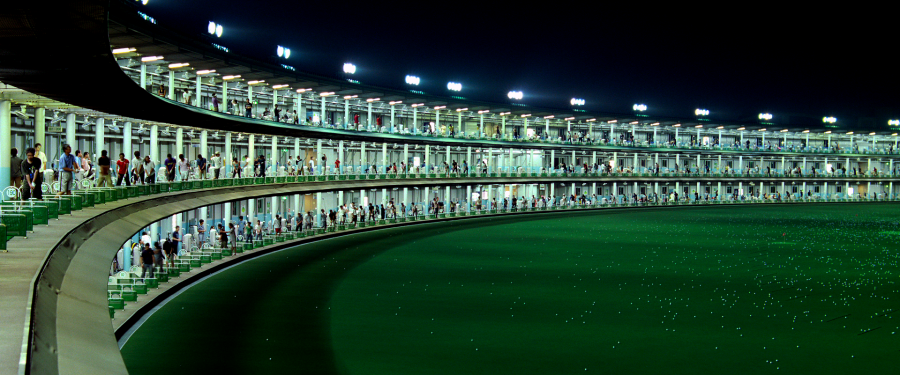One of the best courses in the region, Misaki CC can be enjoyed by all levels of golfer and welcomes foreign guests. Misaki is located just 30 minutes...
Latest advice

Osaka's Best Golf Shops
Osaka Is Japan's second-largest city, located in the Kansai area in West Japan. It is a particularly popular golf destination with 34 courses in its immediate vicinity but is situated also ideally next to Kyoto, Kobe, and Mie which combined have over 100 courses, not to mention the extensive
How to practice on the golf range
By Bennett Galloway
Get the most out of your balls..! (and no, nothing to do with Tiger..)
In this feature, I have enlisted the help of renowned Boston University Athletic Enhancement Center sports psychology coach Adam Naylor to take us through the ins and outs of hitting balls on Japanese driving ranges that produce a teed-up ball every 2.5 seconds!
Adam, thank you for taking some time out to address this issue and help us get the most out of an inner city driving range experience and not potentially harm our fragile egos and swings! Firstly how did you get into coaching/ sports psychology and what was the path that brought you to Boston University.
Thanks, Bennett, my pleasure. Well, my father is a Congregational minister and avid sports participant/fan. Over the years, he has managed to marry these two pursuits well - lots of counseling has happened on high school basketball courts and many corporate CEO's have shared some thoughts with him over 18 holes of golf. So in a lot of ways, you could say that I went into the "family business," but left religious aspect to those in the churches. From here, I studied psychology and the sports sciences starting a bit in high school, then at Trinity College (CT), and on through my doctoral work at Boston University (which concluded in 2001). During all of that time, and the time since I have had the opportunity to work with athletes in all sports and of all levels. Most recently, I've spent significant time helping hockey players find their way from prospect to professional, club through young professional golfers find mental consistency, and even worked with UFC contenders in preparation for the octagon.
Wow, that's pretty impressive!
I recently formed a golf committee within the American Chamber of Commerce Japan, (look for us on LinkedIn) and one of our events is a monthly driving range session near Tokyo at the biggest driving range in the world (I'm told) Lotte Kasai. It's definitely all you'd expect from a high end Japanese automated driving range. And, as I usually see a lot of bad habits as I walk the line, I wanted to ask you, is a teed up ball every 2.5 seconds a blessing or a curse?
Well, it depends on your goal··· a blessing if you are looking for a great aerobic workout. A potential curse if you are hoping to develop a mindful approach to your golf. It is rare that a ball is teed up every 2.5 seconds on the course!
What suggestions do you have to help us slow it down and avoid, not only muscle injury but also creating an unrealistic setting and rhythm that we might not be able to reproduce on the course when it counts?
First, before a ball is hit, remind yourself of your purpose for this time on the range. If it is to beat out some frustration or to simply get a workout, rapid-fire swinging might not be such a bad idea. However, most people head to the range to improve their upcoming rounds of golf. With this in mind, at very least take a moment to think about the flight plan (i.e. shot shape and height) and the landing spot (i.e. target) of your upcoming swing. This will only take a few moments but is certainly a necessary habit to develop for consistent play.
A higher level up from just thinking flight and target, is executing your full pre-shot routine prior to each swing. The goal of a routine is to have your feeling focused and truly ready for each swing. With this in mind practice a relaxing waggle, nice deep breath, or whatever action centers you a bit. Take a moment to see your shot and its target. Then settle into the swing. It takes a bit longer but is also a bit more purposeful when it comes to practice behaviors.
Perhaps the highest level of quality time on the range is pulling a scorecard from your bag and "playing" the course of your choice. Use your gift for daydreaming to play the course from tee to green. Pick the right club for your tee shot and continue to do so once you determine where the ball has landed on the hole in which you are playing. Working your way through a card this way allows you to use your clubs just as you would on-course. You might not be hitting balls every 2.5 seconds, but it is likely you will play eighteen holes in around thirty minutes.
How much truth is there to muscle memory?
Muscle memory is an important thing. It is unhelpful to be re-teaching yourself how to swing each time you address the ball. Few realize that technical swing thoughts on the course are not terribly useful to the experienced golfer - thoughts about targets and fluid swings are keys to success. With this in mind, "overlearning" a skill lets us focus on targets.
This being said, it is important to realize that no two lies are ever the same on the golf course. As perfect as one's swing might be, one will be always faced with different grass below the ball, different angles of the feet, etc. It is with this in mind that a golfer needs to be a bit thoughtful in the approach to each swing.
Being a great golfer requires a balance between trusting one's swing and thinking about the right shot for the situation.
How would you suggest we take the range to the course?
I have two quick thoughts. The first I mentioned above - bring the course to the range more often. Too often we worry about getting our range swing onto the course. Instead, take some time to groove our swing on the range with the challenges of the course in mind.
Second when on the course, appreciate and accept the challenges of the natural setting. You certainly won't have a perfectly teed up ball all day, so accept this reality, commit to your routine, and let it rip. Everyone strives for perfection, but it is the fool that requires it. Golf is about taking the good swings with the not so good and being committed to competing well until the ball has it the bottom of the cup on the 18th hole.
I have heard that one should avoid practicing with wedges at the range as a properly struck wedge requires a downward blow with a steep attack angle, and a range mat causes people to sweep to avoid elbow and wrist injuries (pain) caused at impact. What's your take on this? Should we leave our wedges in the bag?
Having comfort over and fun with the wedges is important to a good round of golf. That being said, there's no sense of hurting oneself on the range if that's the case. If there is the option to hit off of natural turf, take it! I'd really rather leave this on to the physical therapists, teaching professionals, and MDs to sort out.
Well, in that case, let me quickly step in here! In my professional opinion, and as a general rule, it is okay to hit wedges at the range but there is less benefit (less realistic feel) than the longer clubs that are hit with shallower attack angles. The danger being that people tend to begin to sweep the wedges and that can lead to thin hit shots off the leading edge that fly too low, and far, i.e. loss of crucial distance control. Certainly, do not continue pounding down with your wedges at the range if you are experiencing pain!
How about target selection? There are usually some mock greens and pins out there. Should we aim for them, or shoot in line with the mat?
Always take advantage of opportunities to hit to targets. Targets both focus our minds before shots and give us feedback about how we swung after. Keeping this in mind, when going from the range to the course - remember to continue to small pick targets. Too often I see golfers on the first tee look out into a big, wide fairway and then lash the tee shot into the woods. This is because they failed to pick a precise target to hit to in that big fairway. Peter Dye's tight fairways might terrify many, but they always help a player focus on a target (too bad this leaves many knees knocking in fear´´´ but that's for another interview!).
Anything else you'd like to add for those of us here in Japan?
Nope, the above ideas are a great starting point for getting the most out of the high tech ranges of Japan. If you are interested in some more practical ideas improving your mental approach to golf check out the books section at www.telos-spc.com where my new book - A Quick 9 for the Mind will be released at the end of this month.
Thank you, Adam, for taking time to answer these questions and experience tells me that many won't change their habits a bit! But, from those of us who will take your wisdom to heart, a warm thank you.
Partner Courses
Browse our featured courses renowned for their hospitality!

Accordia Golf Narashino Country Club
習志野カントリークラブ
The host course for the ZOZO Championship on the PGA tour, Narashino Country Club has always been at the heart of tournament golf in Japan. Starting...

Kanagawa C.C.
神奈川カントリークラブ
Designed in 1968, Kanagawa C.C. is one of the older courses in the Kanagawa area. Known for its tricky layout, a golfer will need a a variety of shots...







